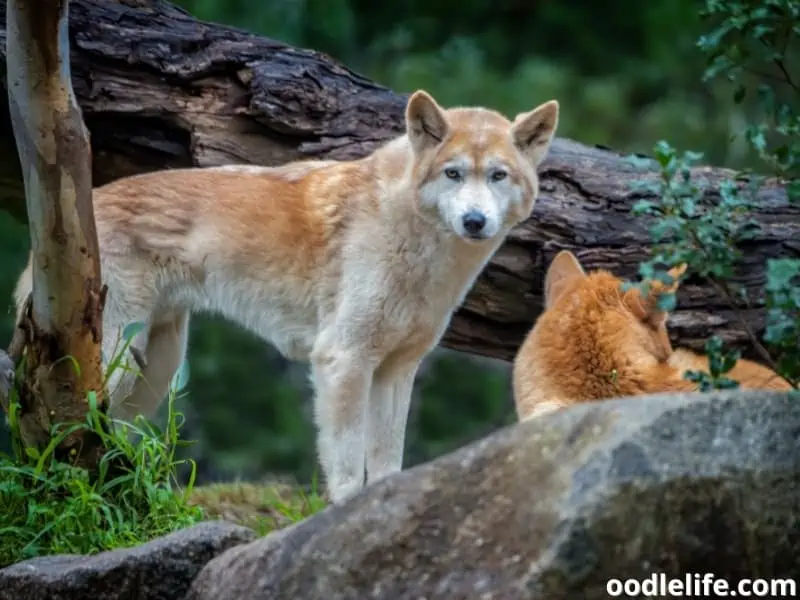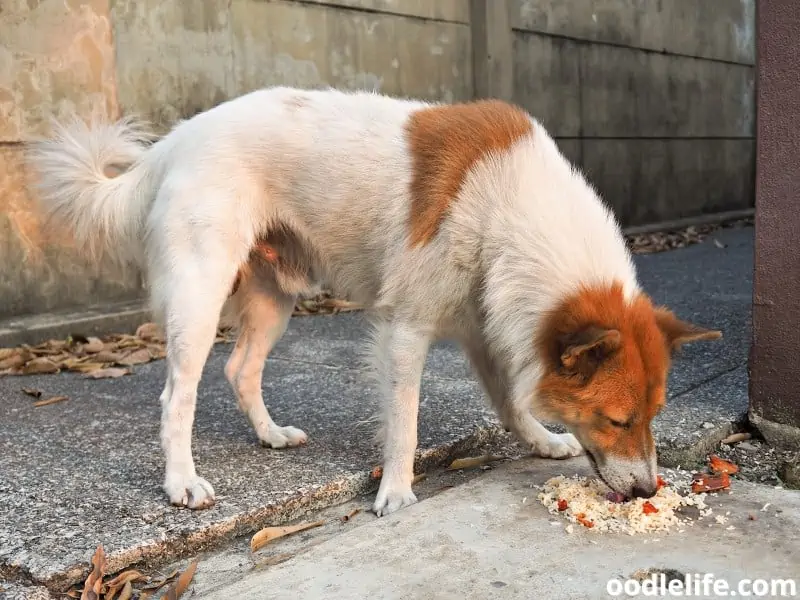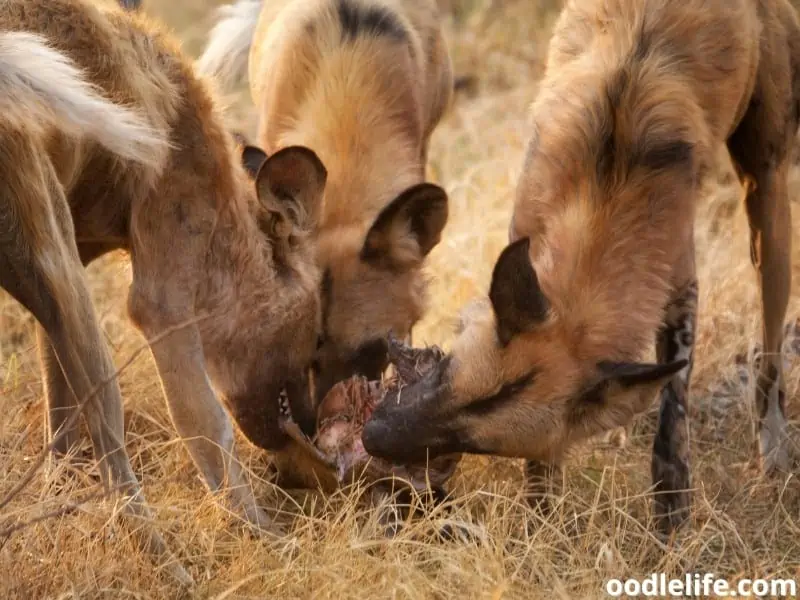What Do Wild Dogs Eat? (Wow)
While we typically think of dogs as domesticated animals, many different species of wild dogs can be found around the world. These dogs vary in size and appearance, but they all share a common ancestor with our beloved pet dogs. So, what do wild dogs eat?
Most wild dogs are carnivores, meaning that they primarily eat meat. This can include anything from rodents and rabbits to larger prey like deer or even livestock. However, in some cases, wild dogs will also scavenge for food, eating carrion or whatever else they can find.

Some species of wild dog, such as the African wild dog, are even proficient hunters, working together in packs to take down their prey.
While the diet of wild dogs may vary depending on the species and location, one thing is for sure: these animals are definitely not picky eaters!
A Variety of Wild Dogs
One of the most common questions we get is, “What’s the difference between a wild dog and a stray?” It’s a good question and one that can be confusing because there are actually several types of wild dogs.
Free-Roaming Domesticated Dogs
It’s not uncommon to see free-roaming domesticated dogs in many neighborhoods. These dogs have a home and an owner but are not restricted to their home and yard.
They are often seen walking or running around freely and sometimes even playing with other dogs or people. While some people may view free-roaming dogs as a nuisance, there are several benefits to this type of arrangement.
For one, it allows the dog to get much-needed exercise and socialization. But on the other hand, dogs cooped up all day can become bored and restless, leading to destructive behaviors.
Allowing them to roam freely can help prevent these problems. Also, free-roaming dogs can act as a neighborhood watch, deterring burglars and strangers from entering the area.
And finally, for dog owners who work long hours or have other commitments that prevent them from walking their dog regularly, free-roaming can provide peace of mind knowing that their pet is getting the exercise it needs.

Stray Dogs
A stray dog is a dog that has been abandoned or lost and is now living on the streets. Stray dogs often suffer from hunger, malnutrition, and diseases such as parvovirus and distemper.
They may also be subject to cruelty from humans. However, many stray dogs are friendly and gentle and need a loving home. If you see a stray dog, the best thing to do is contact your local animal shelter or rescue group.
They will be able to provide the dog with food, shelter, and medical care, eventually finding it a permanent home.
In the meantime, you can help by feeding the dog and providing it with some water.

Feral Dogs
A feral dog is a free-ranging dog that has returned to a wild or undomesticated state. Feral dogs are typically descended from domesticated dogs that have been abandoned or allowed to roam free.
They may live in packs or alone and tend to avoid contact with humans. While most feral dogs are relatively benign, some may be aggressive, particularly if they feel threatened or are protecting their food or territory.
In some areas, feral dogs are considered a nuisance or even a danger, and efforts are often made to control their populations. In other areas, however, feral dogs are tolerated or even welcomed, as they can help to control populations of rodents and other pests.

Dingoes
Dingoes are a type of feral dog that is found in Australia. They are considered one of the country’s most dangerous animals, and attacks on humans are not uncommon.
However, Dingoes are also an essential part of the Australian ecosystem and play a vital role in controlling other feral populations. In recent years, there has been a debate over whether or not to cull Dingoes, but many conservationists believe that this would be detrimental to the environment.
As a result, the future of the Dingo population remains uncertain. However, regardless of their status, Dingoes continue to be an iconic part of Australian life.

New Guinea Singing Dogs
New Guinea Singing dogs are a type of wild dog native to the island of New Guinea. These dogs are known for their unique vocalizations, including howling, yodeling, and other sounds resembling human speech.
Singing dogs are relatively small, weighing between 20 and 30 pounds. They have pointed ears and a coat typically dark brown or black with white markings.
Although they are technically classified as wild animals, some New Guinea Singing dogs have been domesticated and now live as pets in homes around the world.

African Wild Dogs
African Wild dogs are a canine native to sub-Saharan Africa. These animals are also sometimes called painted wolves, or African painted dogs.
African Wild dogs are known for their unique appearance, including a mottled coat of fur that is black, brown, and white.
These animals are also relatively large, with males averaging about 36 pounds and females averaging about 31 pounds. African Wild dogs live in packs of 6 to 20 individuals, and these packs typically include one or two breeding males, several non-breeding males, and several females.
These animals are predators and primarily hunt antelope and other medium-sized mammals. African Wild dogs are endangered, with only about 6,600 individuals remaining in the wild. Habitat loss and conflict with humans are the primary threats to these animals.

What Do the Different Types of Wild Dogs Eat?
Wild dogs are predators that typically hunt in packs. Their diet consists mainly of meat, but they will also eat fruit, vegetables, and other plant matter. Wild dogs have been known to eat just about anything they can catch, including rodents, lizards, birds, and even larger mammals.
While they typically hunt during the day, they also scavenge for food at night. Wild dogs will often cache surplus food to access it later. This behavior helps to ensure that the pack has enough to eat in times of scarce resources.
Strays and Free-Roaming Domesticated Dogs’ Diet
Regarding food, stray dogs and free-roaming domesticated dogs are not all that different. Both will scavenge for food wherever they can and eat just about anything they can get their mouths on.
However, there are some notable differences in the diets of these two dogs. Stray dogs often have to fend for themselves, so they tend to eat whatever they can find. This usually includes garbage, carrion, and other food unsuitable for human consumption.
On the other hand, free-roaming domesticated dogs typically have access to a regular supply of dog food.
While they may still scavenge for scraps from time to time, their diet is generally much better than that of a stray dog.

Feral Dogs’ Diet
Feral dogs are often considered scavengers, but they have a very diverse diet. In addition to eating garbage and carrion, they hunt small animals, raid crops, and scavenge fruit.
In urban areas, they may eat handouts from humans. Feral dogs will also consume grass, which helps them digest their food properly. Although they are opportunistic eaters, feral dogs typically prefer fresh meat.
This preference likely stems from their ancestry as wolves, which are carnivores.
However, the diet of a feral dog can vary depending on their environment and what resources are available to them.

Dingoes’ Diet
Dingoes are such versatile animals, and they have to be to survive in the wild. Therefore, their diet consists of various things, including small mammals, lizards, birds, and even snakes!
They will also eat fruits and vegetables as well as carrion. And yes, they will also scavenge on food left behind by other animals. This is all dependent on what is available to them at the time and what their body needs.
For example, during summer, when there are more lizards around, they will consume more than usual because of the abundance and because lizards contain more moisture, which is essential for survival in hot conditions.
Similarly, in winter, when small mammals are harder to find, they will eat more available fruits and vegetables. So as you can see, the Dingo’s diet is quite varied and ever-changing depending on the season and what their surroundings offer.

New Guinea Singing Dogs’ Diet
New Guinea Singing Dogs’ diets must be carefully balanced to maintain their health and energy levels. These dogs are known for their high activity level, and they require a diet rich in protein and fat.
A typical diet for a New Guinea Singing Dog may include meat, organs, bones, and a small number of vegetables. This diet provides these dogs the nutrients to stay healthy and active. In addition, it helps to keep their coats shiny and their skin healthy.
New Guinea Singing Dogs are also known for their love of treats and will often beg for tidbits from their owners.
As a result, it is important to ensure that their diet includes plenty of healthy snacks. Following these tips can help your New Guinea Singing Dog stay healthy and happy.

African Wild Dogs’ Diet
African Wild dogs are predators that hunt in packs. Their diet consists primarily of medium to large-sized animals such as antelope, gazelles, and zebra. While they will also eat smaller prey like rodents, lizards, and birds, these make up a small percentage of their overall diet.
African Wild dogs are efficient hunters and kill an average of one large animal every two days. When a pack brings down a large animal, they will eat their fill and often cache the remainder of the carcass for later. This behavior helps to ensure that the pack always has access to food, even during lean times.
While African Wild dogs are skilled hunters, they are also very social animals. They live in packs of up to 40 individuals and rely on cooperative behavior to make a successful kill.
If a pack member becomes injured or sick, the others will help care for them until they recover. In this way, African Wild dogs provide an important example of the power of cooperation.

Final Thoughts
When you think about it, it makes perfect sense that a dog’s diet in the wild would be pretty similar regardless of where they happen to live. After all, dogs are opportunistic eaters – they’ll eat whatever they can get their paws on.
So, whether in the arctic or the desert, you can bet that they’ll be chowing down on meat, vegetation, and trash. The only real difference would be in the availability of food, which would vary depending on the environment.
But overall, a wild dog’s diet is pretty much the same no matter where they roam.